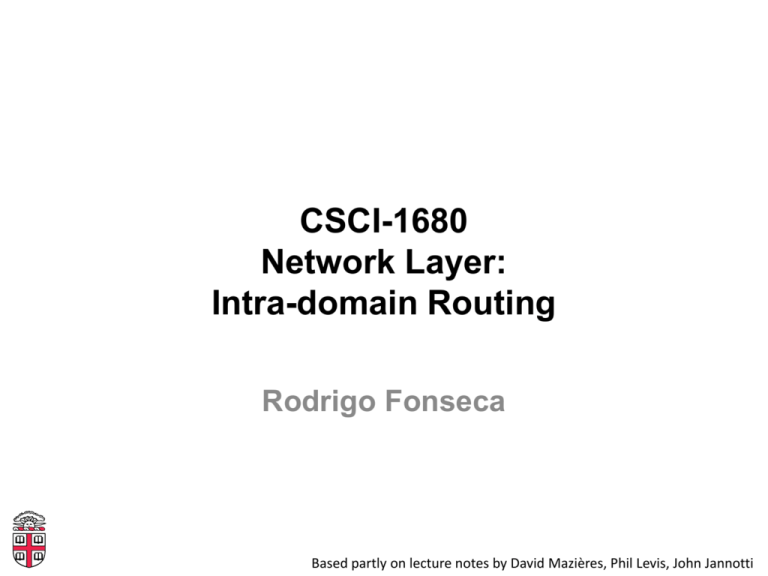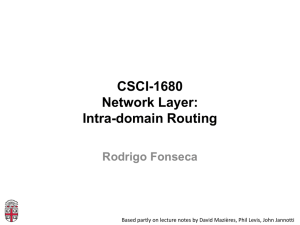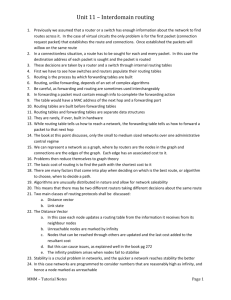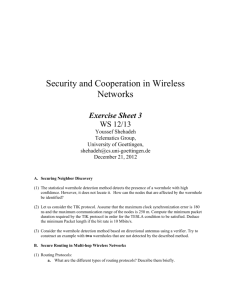pptx
advertisement

CSCI-1680
Network Layer:
Intra-domain Routing
Rodrigo Fonseca
Based partly on lecture notes by David Mazières, Phil Levis, John Jannotti
Today
• Intra-Domain Routing
• Next class: Inter-Domain Routing
Routing
• Routing is the process of updating
forwarding tables
– Routers exchange messages about routers or
networks they can reach
– Goal: find optimal route for every destination
– … or maybe a good route, or any route
(depending on scale)
• Challenges
– Dynamic topology
– Decentralized
– Scale
Scaling Issues
• Every router must be able to forward
based on any destination IP address
– Given address, it needs to know next hop
– Naïve: one entry per address
– There would be 108 entries!
• Solutions
– Hierarchy (many examples)
– Address aggregation
• Address allocation is very important (should mirror
topology)
– Default routes
IP Connectivity
• For each destination address, must either:
– Have prefix mapped to next hop in forwarding table
– Know “smarter router” – default for unknown prefixes
• Route using longest prefix match, default is
prefix 0.0.0.0/0
• Core routers know everything – no default
• Manage using notion of Autonomous
System (AS)
Internet structure, 1990
• Several independent organizations
• Hierarchical structure with single
backbone
Internet structure, today
• Multiple backbones, more arbitrary
structure
Autonomous Systems
• Correspond to an administrative domain
– AS’s reflect organization of the Internet
– E.g., Brown, large company, etc.
– Identified by a 16-bit number
• Goals
– AS’s choose their own local routing algorithm
– AS’s want to set policies about non-local routing
– AS’s need not reveal internal topology of their
network
Inter and Intra-domain routing
• Routing organized in two levels
• Intra-domain routing
– Complete knowledge, strive for optimal paths
– Scale to ~100 networks
– Today
• Inter-domain routing
– Aggregated knowledge, scale to Internet
– Dominated by policy
• E.g., route through X, unless X is unavailable, then
route through Y. Never route traffic from X to Y.
– Policies reflect business agreements, can get
complex
– Next lecture
Intra-Domain Routing
Network as a graph
• Nodes are routers
• Assign cost to each edge
– Can be based on latency, b/w, queue length, …
• Problem: find lowest-cost path between
nodes
– Each node individually computes routes
Basic Algorithms
• Two classes of intra-domain routing
algorithms
• Distance Vector
– Requires only local state
– Harder to debug
– Can suffer from loops
• Link State
– Each node has global view of the network
– Simpler to debug
– Requires global state
Distance Vector
• Local routing algorithm
• Each node maintains a set of triples
– <Destination, Cost, NextHop>
• Exchange updates with neighbors
– Periodically (seconds to minutes)
– Whenever table changes (triggered update)
• Each update is a list of pairs
– <Destination, Cost>
• Update local table if receive a “better”
route
– Smaller cost
• Refresh existing routes, delete if time out
Calculating the best path
• Bellman-Ford equation
• Let:
– Da(b) denote the current best distance from a to b
– c(a,b) denote the cost of a link from a to b
• Then Dx(y) = minz(c(x,z) + Dz(y))
• Routing messages contain D
• D is any additive metric
– e.g, number of hops, queue length, delay
– log can convert multiplicative metric into an additive
one (e.g., probability of failure)
DV Example
B’s routing table
Destination
Cost
Next Hop
A
1
A
C
1
C
D
2
C
E
2
A
F
2
A
G
3
A
Adapting to Failures
G, 3, D
G, 2, D
G, 3,C
2, F
∞,-
G, 1, G
G, 4,
3, A
1, A
GG, ∞,
4,
•
•
•
•
F-G fails
F sets distance to G to infinity, propagates
A sets distance to G to infinity
A receives periodic update from C with 2-hop
path to G
• A sets distance to G to 3 and propagates
• F sets distance to G to 4, through A
Count-to-Infinity
•
•
•
•
•
•
•
Link from A to E fails
A advertises distance of infinity to E
B and C advertise a distance of 2 to E
B decides it can reach E in 3 hops through C
A decides it can reach E in 4 hops through B
C decides it can reach E in 5 hops through A, …
When does this stop?
Good news travels fast
B
1
4
1
A
C
10
• A decrease in link cost has to be fresh
information
• Network converges at most in O(diameter)
steps
Bad news travels slowly
12
B
4
1
A
C
10
• An increase in cost may cause confusion with old
information, may form loops
• Consider routes to A
• Initially, B:A,4,A; C:A,5,B
• Then B:A,12,A, selects C as next hop -> B:A,6,C
• C -> A,7,B; B -> A,8,C; C -> A,9,B; B -> A,10,C;
• C finally chooses C:A,10,A, and B -> A,11,C!
How to avoid loops
• IP TTL field prevents a packet from living
forever
– Does not repair a loop
• Simple approach: consider a small cost n
(e.g., 16) to be infinity
– After n rounds decide node is unavailable
– But rounds can be long, this takes time
• Problem: distance vector based only on
local information
Better loop avoidance
• Split Horizon
– When sending updates to node A, don’t include
routes you learned from A
– Prevents B and C from sending cost 2 to A
• Split Horizon with Poison Reverse
– Rather than not advertising routes learned from
A, explicitly include cost of ∞.
– Faster to break out of loops, but increases
advertisement sizes
Warning
• Split horizon/split horizon with poison
reverse only help between two nodes
– Can still get loop with three nodes involved
– Might need to delay advertising routes after
changes, but affects convergence time
Other approaches
• DSDV: destination sequenced distance
vector
– Uses a ‘version’ number per destination
message
– Avoids loops by preventing nodes from using old
information from descendents
– But, you can only update when new version
comes from root
• Path Vector: (BGP)
– Replace ‘distance’ with ‘path’
– Avoids loops with extra cost
Link State Routing
• Strategy:
– send to all nodes information about directly
connected neighbors
• Link State Packet (LSP)
–
–
–
–
ID of the node that created the LSP
Cost of link to each directly connected neighbor
Sequence number (SEQNO)
TTL
Reliable Flooding
• Store most recent LSP from each node
– Ignore earlier versions of the same LSP
• Forward LSP to all nodes but the one that
sent it
• Generate new LSP periodically
– Increment SEQNO
• Start at SEQNO=0 when reboot
– If you hear your own packet with SEQNO=n, set your
next SEQNO to n+1
• Decrement TTL of each stored LSP
– Discard when TTL=0
Calculating best path
• Djikstra’s single-source shortest path
algorithm
– Each node computes shortest paths from itself
• Let:
– N denote set of nodes in the graph
– l(i,j) denote the non-negative link between i,j
• ∞ if there is no direct link between i and j
– C(n) denote the cost of path from s to n
– s denotes yourself (node computing paths)
• Initialize variables
– M = {s} (set of nodes incorporated thus far)
– For each n in N-{s}, C(n) = l(s,n)
– Next(n) = s if l(s,n) < ∞, – otherwise
Djikstra’s Algorithm
• While N≠M
– Let w ∈(N-M) be the node with lowest C(w)
– M = M {w}
– Foreach n ∈ (N-M), if C(w) + l(w,n) < C(n)
then C(n) = C(w) +
l(w,n), Next(n) = w
• Example: D: (D,0,-) (C,2,D) (B,5,C)
(A,10,B)
Distance Vector vs. Link State
• # of messages (per node)
– DV: O(d), where d is degree of node
– LS: O(nd) for n nodes in system
• Computation
– DV: convergence time varies (e.g., count-to-infinity)
– LS: O(n2) with O(nd) messages
• Robustness: what happens with
malfunctioning router?
– DV: Nodes can advertise incorrect path cost
– DV: Others can use the cost, propagates through
network
– LS: Nodes can advertise incorrect link cost
Metrics
• Original ARPANET metric
– measures number of packets enqueued in each link
– neither latency nor bandwidth in consideration
• New ARPANET metric
– Stamp arrival time (AT) and departure time (DT)
– When link-level ACK arrives, compute
Delay = (DT – AT) + Transmit + Latency
– If timeout, reset DT to departure time for
retransmission
– Link cost = average delay over some time period
• Fine Tuning
– Compressed dynamic range
– Replaced Delay with link utilization
• Today: commonly set manually to achieve
specific goals
Examples
• RIPv2
– Fairly simple implementation of DV
– RFC 2453 (38 pages)
• OSPF (Open Shortest Path First)
– More complex link-state protocol
– Adds notion of areas for scalability
– RFC 2328 (244 pages)
RIPv2
• Runs on UDP port 520
• Link cost = 1
• Periodic updates every 30s, plus
triggered updates
• Relies on count-to-infinity to resolve
loops
– Maximum diameter 15 (∞ = 16)
– Supports split horizon, poison reverse
• Deletion
– If you receive an entry with metric = 16 OR
– If a route times out
Packet format
RIPv2 Entry
Route Tag field
• Allows RIP nodes to distinguish internal
and external routes
• Must persist across announcements
• E.g., encode AS
Next Hop field
• Allows one router to advertise routes for
multiple routers on the same subnet
• Suppose only XR1 talks RIPv2:
OSPFv2
• Link state protocol
• Runs directly over IP (protocol 89)
– Has to provide its own reliability
• All exchanges are authenticated
• Adds notion of areas for scalability
OSPF Areas
• Area 0 is “backbone” area (includes all
boundary routers)
• Traffic between two areas must always
go through area 0
• Only need to know how to route exactly
within area
• Otherwise, just route to the appropriate
area
• Tradeoff: scalability versus optimal
routes
OSPF Areas
Next Class
• Inter-domain routing: how scale routing
to the entire Internet











